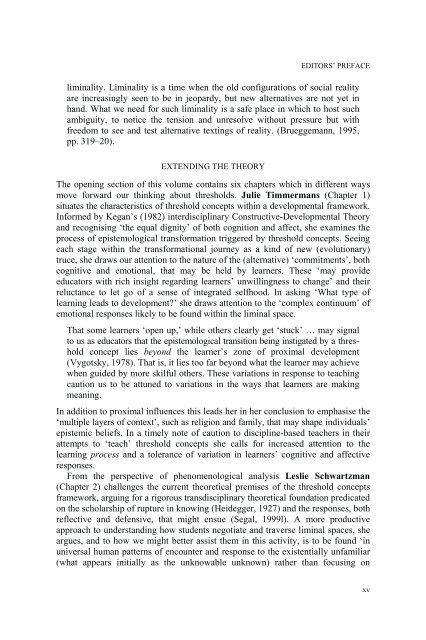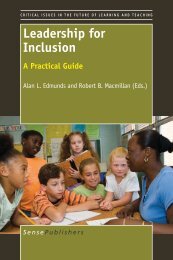1177-threshold-concepts-and-transformational-learning
1177-threshold-concepts-and-transformational-learning
1177-threshold-concepts-and-transformational-learning
- No tags were found...
You also want an ePaper? Increase the reach of your titles
YUMPU automatically turns print PDFs into web optimized ePapers that Google loves.
EDITORS’ PREFACEliminality. Liminality is a time when the old configurations of social realityare increasingly seen to be in jeopardy, but new alternatives are not yet inh<strong>and</strong>. What we need for such liminality is a safe place in which to host suchambiguity, to notice the tension <strong>and</strong> unresolve without pressure but withfreedom to see <strong>and</strong> test alternative textings of reality. (Brueggemann, 1995,pp. 319–20).EXTENDING THE THEORYThe opening section of this volume contains six chapters which in different waysmove forward our thinking about <strong>threshold</strong>s. Julie Timmermans (Chapter 1)situates the characteristics of <strong>threshold</strong> <strong>concepts</strong> within a developmental framework.Informed by Kegan’s (1982) interdisciplinary Constructive-Developmental Theory<strong>and</strong> recognising ‘the equal dignity’ of both cognition <strong>and</strong> affect, she examines theprocess of epistemological transformation triggered by <strong>threshold</strong> <strong>concepts</strong>. Seeingeach stage within the <strong>transformational</strong> journey as a kind of new (evolutionary)truce, she draws our attention to the nature of the (alternative) ‘commitments’, bothcognitive <strong>and</strong> emotional, that may be held by learners. These ‘may provideeducators with rich insight regarding learners’ unwillingness to change’ <strong>and</strong> theirreluctance to let go of a sense of integrated selfhood. In asking ‘What type of<strong>learning</strong> leads to development?’ she draws attention to the ‘complex continuum’ ofemotional responses likely to be found within the liminal space.That some learners ‘open up,’ while others clearly get ‘stuck’ … may signalto us as educators that the epistemological transition being instigated by a <strong>threshold</strong>concept lies beyond the learner’s zone of proximal development(Vygotsky, 1978). That is, it lies too far beyond what the learner may achievewhen guided by more skilful others. These variations in response to teachingcaution us to be attuned to variations in the ways that learners are makingmeaning.In addition to proximal influences this leads her in her conclusion to emphasise the‘multiple layers of context’, such as religion <strong>and</strong> family, that may shape individuals’epistemic beliefs. In a timely note of caution to discipline-based teachers in theirattempts to ‘teach’ <strong>threshold</strong> <strong>concepts</strong> she calls for increased attention to the<strong>learning</strong> process <strong>and</strong> a tolerance of variation in learners’ cognitive <strong>and</strong> affectiveresponses.From the perspective of phenomenological analysis Leslie Schwartzman(Chapter 2) challenges the current theoretical premises of the <strong>threshold</strong> <strong>concepts</strong>framework, arguing for a rigorous transdisciplinary theoretical foundation predicatedon the scholarship of rupture in knowing (Heidegger, 1927) <strong>and</strong> the responses, bothreflective <strong>and</strong> defensive, that might ensue (Segal, 1999l). A more productiveapproach to underst<strong>and</strong>ing how students negotiate <strong>and</strong> traverse liminal spaces, sheargues, <strong>and</strong> to how we might better assist them in this activity, is to be found ‘inuniversal human patterns of encounter <strong>and</strong> response to the existentially unfamiliar(what appears initially as the unknowable unknown) rather than focusing onxv




